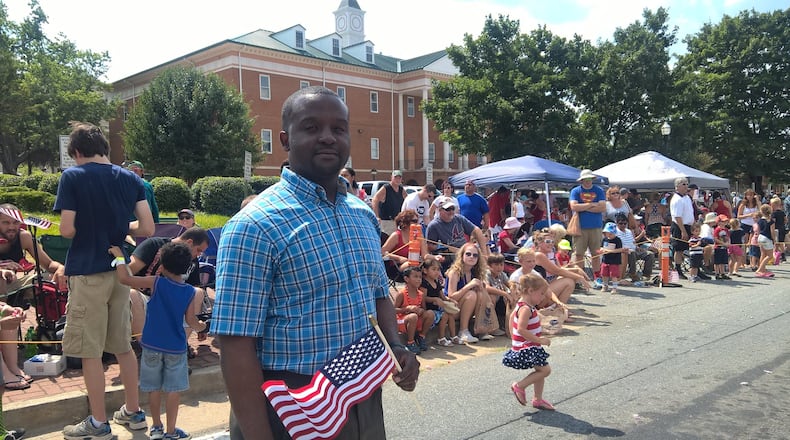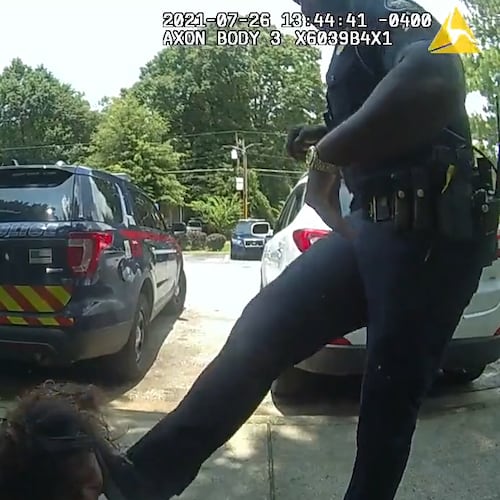Mae Crow, a Forsyth County woman whose murder a century ago unleashed white-on-black bloodshed, is buried less than 5 miles from the Forsyth school that fired a staffer last month for racist postings about Michelle Obama.
In its largest city of Cumming, the first black man to run for any elected position in Forsyth can step out of his downtown campaign office and see where a black boy was lynched for allegedly killing Crow in 1912.
It’s all part of the fabric of Forsyth, a county that is one of metro Atlanta’s most affluent, yet still grapples with a racist image codified 104 years ago with the purge of all its black residents — more than 1,000 people.
It’s a Georgia story that resonates anew in a U.S. presidential election season that has been rife with racial overtones, pitched battles about who’s to blame for the nation’s ills, and shrill rhetoric about who has the right to live in this country.
For Many, A Beautiful Place To Call Home
Forsyth, 40 miles north of Atlanta, near the Blue Ridge Mountains, is a bucolic suburb with a small-town feel.
According to 2015 census figures, of the 212,000 people who live in Forsyth, 75 percent of them are white. Asians and Hispanics are the dominant minorities at 10.3 and 9.6 percent respectively, while blacks make up less than 4 percent of the population.
With a median household income of more than $85,000 and a homeownership rate of nearly 86 percent, Forsyth is the "richest" county in Georgia.
The school system is one of the best in the state, with a 93 percent graduation rate versus the 79 percent state average. Ninety-two percent of Forsyth's black students graduate, the highest rate in any county in metro Atlanta.
Those are some of the factors that attract people to the area.
Genesis Rivas, a Venezuelan, his Ecuadorian wife and their children moved into a culturally diverse Forsyth community nearly five years ago. The one time he was stopped by police for a traffic violation, the officer let him off with a warning and told him to watch out for deer.
“The history of Forsyth is pretty shocking, but if you didn’t study the history, you wouldn’t know it,” Rivas said. “The experience that I have had so far is totally different. Overall, things have changed for the better.”
For Others, Still An Ugly Haven of Bigotry
Forsyth was in the news in October because Jane Wood Allen, a paraprofessional at Chestatee Elementary School, called first lady Michelle Obama "a gorilla" on Facebook.
Allen was fired, but it marked the second time this year that a Forsyth school official was reprimanded over social media. In January, Lambert High School Principal Gary Davison was placed on administrative leave after posting political and religious statements that some found offensive, such as "one nation under God, not Allah."
“I just think it challenges one of the narratives of Forsyth County now, which is the progressive narrative,” said Patrick Phillips, an author and poet raised in Forsyth who now lives in New York. “According to that story, each day America gets a little more just and lets go of its racist past. But running alongside it is racism and bigotry. This just confirms that some of the old isolation and bigotry still remains.”
Phillips, who is white, was in the second grade in 1977 when his family moved to Forsyth from Sandy Springs.
His parents were looking for a bedroom community outside of the city, and the recently completed Ga. 400 made Forsyth ideal. But he noticed that there were few blacks around. He noticed how comfortable his classmates were with the N-word. And he noticed the occasional Ku Klux Klan rally.
A White Woman’s Murder And Black Bloodshed
Phillips' latest book, "Blood at the Root," published this October, recounts in detail the horrible events of 1912 and their lingering impact on the county.
Nineteen-year-old Mae Crow went missing on Sept. 8, 1912, from a part of the county then known as Oscarville. A day later, she was found beaten, allegedly raped, and clinging to life in the woods.
Although there were no witnesses and Crow was unconscious (she would die two weeks later), black boys in the area were rounded up. Two teenagers were arrested, including one who confessed with a noose around his neck.
The two, Ernest Knox and Oscar Daniel, were eventually tried and hung for murder.
A third man, Rob Edwards, was snatched out of jail, beaten, dragged and shot, and his bullet-ridden body hung in the town square. Mobs then fanned the county, beating, dynamiting and burning down black homes.
Every black person in the county — more than 1,000 — was driven out.
Despite tales that the Klan was behind the purge — the terror group in its modern form did not appear until 1915 — Phillips writes that it was government and law enforcement indifference that enabled ordinary white citizens to turn against their neighbors.
“The Klan story was a way of deflecting guilt,” Phillips said.
A Dogged Determination Not To Diversify?
In 1910, Forsyth County had 1,098 black residents. That number plunged to 30 by 1920, and to 17 by 1930, according to census data tracked by the National Historical Geographic Information System at the University of Minnesota.
Forsyth would remain nearly all-white throughout the rest of the century.
Some activists tried to change that. In 1987, civil rights legend and Atlanta resident Hosea Williams and hundreds of others, including Phillips’ parents, marched through Forsyth to declare it was too white. To argue that racism had kept blacks out. To decry the county as an anachronism and an affront.
The protesters encountered brick-throwing resistance from residents, and Klansmen waving Confederate flags and shouting, “Keep Forsyth white.”
Oprah Winfrey even showed up with TV cameras in the wake of the rally.
No matter. Only 14 black people lived in Forsyth in 1990.
A Descendant Pushes Back Against Prejudice
African-Americans weren’t the only ones who fled Forsyth. After Mae Crow’s death, Crow’s family moved to Hall County.
On Sept. 9, 1955, exactly 43 years to the day that Mae Crow was found, her grandniece Debbie Vermaat was born. Vermaat grew up hearing about her great-aunt’s murder, and her grandmother once took her to the tree where Crow’s body was found.
Many in the family had hated blacks, “but she told me not to ever let hate hold a place in my heart,” Vermaat said of her grandmother Esta Crow, who was Mae Crow’s youngest sister.
Moreover, Vermaat said that shortly before her grandmother died, she wrote a letter saying she doubted the black boys hanged for the killing were actually involved.
Vermaat grew to reject race-based fear and paranoia. She said she moved to New Jersey 41 years ago because she didn’t want to raise her children in a racist environment. “I wanted to push back against that narrative.”
How An International Family Fits In
Jack Whedbee, whose father is white and whose mother is Puerto Rican, has traveled the world as a missionary. He moved to Forsyth right after 9/11 mainly because his parents lived there and he wanted to raise his kids around their grandparents.
He knows about Forsyth’s history of racial hostility. “I had heard the stories and people told me about the lynchings,” said Whedbee, who attends a Unitarian church with his Japanese wife, Yukari, and their four children. “Because the essence of our church is restoration, my whole adult life has been facing this stuff.”
Their church is in Ellenwood, about 20 miles south of Atlanta. And Whedbee recalls that on occasion, when he’d drive home from church with black friends in tow, he’d have to assure them they’d be safe in Forsyth.
“I remain faithful that humans can overcome their fallen nature and restore the original nature that was pure, true and good. Godly,” said Whedbee. “Even the worst person has a small seed of goodness.”
No doubt. Still, his daughter, Soon-Mi, who was born in Russia, said it was tough at times growing up in Forsyth.
“Coming here was culture shock,” she said. “A lot of kids didn’t know what I was. Once I left and went to college, it made me look back at this place and realize that this is just a bubble.”
A Black Man Runs, And Not For His Life
Recently, as Election Day loomed, Forsyth’s Democratic challenger for the state’s 27th Senate District canvassed the staunchly Republican county, knocking on doors and shaking hands.
He is the first African-American to qualify for any local or statewide seat in Forsyth.
His name? Daniel Blackman.
Seriously.
“The first time people meet me, they sometimes ask if that is my real name,” said the candidate, who has lived in Forsyth for four years. “My last name and the irony that comes with it are part of the territory. It brings a lot full circle.”
Blackman and his wife were invited to a party in Forsyth in 2011 and fell in love with the area — especially its schools. “We want our children to be in a school that is as competitive as possible,” he said.
There have been times he’s heard the N-word. Yet Blackman said he's never felt in danger.
As for his candidacy, Blackman knew the odds favored his opponent, incumbent Michael E. Williams, a Donald Trump supporter.
In the end, he scored 22 percent of the vote against Williams. But beneath the numbers, his 20,129 votes were only 3,298 fewer than fellow Democrat Hillary Clinton got in her bid for the White House, and 1,992 more than Democrat Jim Barksdale got in his run for the U.S Senate.
“We had work to do, but the response has been overwhelming,” Blackman said Wednesday afternoon. “People have been asking me if I am going to stay in Forsyth County, and am I going to continue to run. The answer is yes, this is my home. And yes, I will continue to run to make Forsyth County better.”
Perhaps change is in the air. Vermaat certainly hopes so. In her house is a photo of Mae Crow sent by her grandmother in that letter expressing doubts that the three black boys were guilty. She said she looks at it every day as a constant reminder.
But Vermaat is looking for another reminder. She has been working with an organization to place markers on the spot of every American lynching.
She wants one in downtown Cumming.
Where Rob Edwards was lynched for allegedly killing her great-aunt. Right down the street from Dan Blackman’s office.
About the Author
The Latest
Featured


